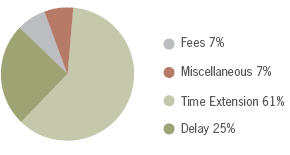2008-2009 Identification of issues
| Previous | Table of contents | Next |
Identifying systemic issues requires us to be aware of trends and recurring patterns in the access to information system. To gather information on these, we scan various sources, such as the complaints we receive, extension notices and written responses to our report cards. We combine that information with observations and conclusions drawn from our own experience and that of our stakeholders to look beyond the symptoms and understand the underlying problem.
An example: time extensions
Federal institutions must complete access to information requests within 30 days of receiving them or take a time extension. Institutions may only take extensions under the specific conditions described in section 9 of the Act. In addition, extensions must be for a reasonable period of time. The use and length of these extensions are not otherwise constrained.
Statistics prepared by the Treasury Board Secretariat for 2007–2008 give a sobering but not alarming picture of the use of extensions: overall, institutions extend 27 percent of requests.3 This fact runs counter to the evidence we found in our report cards process, analysis of the complaints we receive and feedback from stakeholders. We found that time extensions are becoming the norm rather than the exception.
Our data show that of all the complaints we received in 2008–2009, 52 percent were administrative ones, about time extensions, deemed refusals, fees and others. As the figure below illustrates, complaints about time extensions represent the largest proportion of administrative complaints. Moreover, a high ratio of administrative complaints is resolved with merit (see Figure 4 in Chapter 3).
3 For more information, go to www.infosource.gc.ca/bulletin/2009/b/bulletin-b03-eng.asp
Figure 1. Breakdown of administrative complaints, 2008–2009

The report cards process brought to light a disturbing trend toward the greater use of extensions and for longer periods of time. This increase could be the result of chronic understaffing of access to information units, deficiencies in records management, tactics to prevent deemed refusals or simply a weak compliance model with limited checks and balances.
Given the inconsistencies in the data available on extensions, we looked more closely at the
Treasury Board Secretariat statistics and found, controlling for extreme values, that around 40 percent of the remaining requests were extended.4 These statistics confirm what we have observed thus far: it takes longer to process access requests today than in previous years, in part because most extensions are for periods beyond 30 days.
As a result, we will closely monitor the notices that institutions have to submit to us about the time extensions they take over 30 days, and we will investigate the use and duration of time extensions.
| Previous | Table of contents | Next |